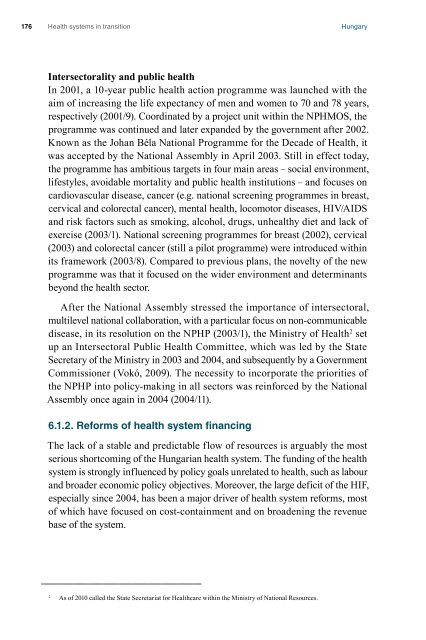Health Systems in Transition - Hungary - World Health Organization ...
Health Systems in Transition - Hungary - World Health Organization ...
Health Systems in Transition - Hungary - World Health Organization ...
Create successful ePaper yourself
Turn your PDF publications into a flip-book with our unique Google optimized e-Paper software.
176<br />
<strong>Health</strong> systems <strong>in</strong> transition <strong>Hungary</strong><br />
Intersectorality and public health<br />
In 2001, a 10-year public health action programme was launched with the<br />
aim of <strong>in</strong>creas<strong>in</strong>g the life expectancy of men and women to 70 and 78 years,<br />
respectively (2001/9). Coord<strong>in</strong>ated by a project unit with<strong>in</strong> the NPHMOS, the<br />
programme was cont<strong>in</strong>ued and later expanded by the government after 2002.<br />
Known as the Johan Béla National Programme for the Decade of <strong>Health</strong>, it<br />
was accepted by the National Assembly <strong>in</strong> April 2003. Still <strong>in</strong> effect today,<br />
the programme has ambitious targets <strong>in</strong> four ma<strong>in</strong> areas – social environment,<br />
lifestyles, avoidable mortality and public health <strong>in</strong>stitutions – and focuses on<br />
cardiovascular disease, cancer (e.g. national screen<strong>in</strong>g programmes <strong>in</strong> breast,<br />
cervical and colorectal cancer), mental health, locomotor diseases, HIV/AIDS<br />
and risk factors such as smok<strong>in</strong>g, alcohol, drugs, unhealthy diet and lack of<br />
exercise (2003/1). National screen<strong>in</strong>g programmes for breast (2002), cervical<br />
(2003) and colorectal cancer (still a pilot programme) were <strong>in</strong>troduced with<strong>in</strong><br />
its framework (2003/8). Compared to previous plans, the novelty of the new<br />
programme was that it focused on the wider environment and determ<strong>in</strong>ants<br />
beyond the health sector.<br />
After the National Assembly stressed the importance of <strong>in</strong>tersectoral,<br />
multilevel national collaboration, with a particular focus on non-communicable<br />
disease, <strong>in</strong> its resolution on the NPHP (2003/1), the M<strong>in</strong>istry of <strong>Health</strong> 2 set<br />
up an Intersectoral Public <strong>Health</strong> Committee, which was led by the State<br />
Secretary of the M<strong>in</strong>istry <strong>in</strong> 2003 and 2004, and subsequently by a Government<br />
Commissioner (Vokó, 2009). The necessity to <strong>in</strong>corporate the priorities of<br />
the NPHP <strong>in</strong>to policy-mak<strong>in</strong>g <strong>in</strong> all sectors was re<strong>in</strong>forced by the National<br />
Assembly once aga<strong>in</strong> <strong>in</strong> 2004 (2004/11).<br />
6.1.2. Reforms of health system f<strong>in</strong>anc<strong>in</strong>g<br />
The lack of a stable and predictable flow of resources is arguably the most<br />
serious shortcom<strong>in</strong>g of the Hungarian health system. The fund<strong>in</strong>g of the health<br />
system is strongly <strong>in</strong>fluenced by policy goals unrelated to health, such as labour<br />
and broader economic policy objectives. Moreover, the large deficit of the HIF,<br />
especially s<strong>in</strong>ce 2004, has been a major driver of health system reforms, most<br />
of which have focused on cost-conta<strong>in</strong>ment and on broaden<strong>in</strong>g the revenue<br />
base of the system.<br />
2 As of 2010 called the State Secretariat for <strong>Health</strong>care with<strong>in</strong> the M<strong>in</strong>istry of National Resources.
















